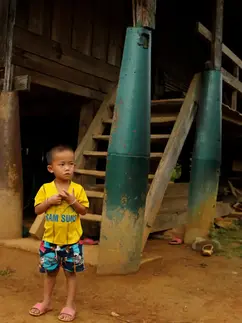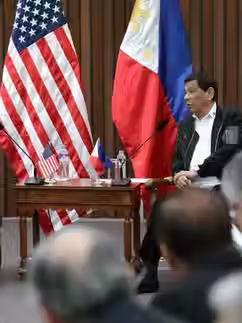Ukrainian Offensives and Russian Rebellions
Remy Szabo

The summer offensive in Ukraine, aimed at reclaiming Russian-occupied territory, began in early June 2023. However, Ukrainian forces have made minimal gains and are currently engaged in attritional fighting against well-established Russian positions. Despite the slow progress, there have been significant developments on the western frontier of the Eurasian Steppe.
How is the offensive going?
Ukrainian forces are attacking on two fronts. The first, south of Zaporizhzhia, intends to cut Russia’s land bridge to the Crimean peninsula. By targeting this area and causing damage to the Kerch Strait bridge, Ukraine is putting pressure on Russia's supply chains to Crimea and Southern Kherson Oblast.
The Eastern axis around Bakhmut in the Donetsk region holds less strategic significance, but both the Ukrainian and Russian governments have placed a great deal of symbolic value on the city. Ukrainian forces are attempting an encirclement of Bakhmut, rather than a potentially costly assault on the city. Victory at Bakhmut will be a major boost to the morale of the victor and increase their political capital. Thus far Ukrainian forces have made ‘modest advances’ on this front, aided by the withdrawal of Wagner Private Military Company (Wagner PMC) troops.
However, the anticipated third front of attack, south of Kherson and west of Zaporizhzhia, was halted at the beginning of the offensive. Russian forces destroyed the Kakhovka dam on the Dnipro river, resulting in extensive flooding and environmental devastation. This act effectively prevents any possibility of an amphibious assault across the Dnipro until the flooding subsides. The resulting mud will impede Ukrainian advancements for months and allow Russian units to be redeployed to other active theatres.
Overall, English language reporting indicates that the offensive is not going well, with Ukrainian forces making minimal territorial gains, none of which appear to be strategic. Russian troops are bedded in and withstanding Ukrainian attacks with two lines of defence; minefields followed by fortified positions. Minefields create a slow paced attritional battlefield. The Ukrainian government estimates that 200,000 sq km of their territory has been mined by the Russians.
We should recognise that in war, as in any other human endeavour, progress is not linear. Ukrainian President Volodymyr Zelenskyy summarised this astutely in a recent interview saying in effect that, ‘war is not a Hollywood movie.’ Part of the disappointment with the offensive thus far surely lies with the high expectations Western supporters of Ukraine had of this long-awaited assault.
Ukrainian forces will continue to probe the Russian line for weak points that can be exploited in the hopes of achieving a breakthrough and an outmanoeuvring of Russian defences. The success, failure, or stalemate of Ukraine's offensive will be determined over several months of sustained effort, rather than in the first month alone.
How will the Wagner rebellion impact the war?
Following the failure of the Wagner rebellion there was an immediate and noticeable uptick in Russian artillery fire and airstrikes in Ukraine evident on open-source intelligence (OSINT) community channels. The Russian Presidency and the leadership of the Ministry of Defence appear to be doubling down on the war, using it to rebuild state legitimacy and public support.
The failed rebellion exposed a previously unseen fragility in the Russian system and Vladimir Putin's rule. Many analyses have hinted at his impending downfall, but it is too early to predict the medium to long-term effects of these events on the Russian state. Commentaries suggesting the imminent collapse of the Putin regime often reflect the authors' hopes rather than sober analysis.
Several Russian regular units reportedly joined the Wagner cause, while others stayed home, leading to ongoing recriminations within the Russian state and Ministry of Defence. The events and subsequent politicking will likely sow doubt and mistrust among the Russian chain of command and regular soldiers. The integration of former Wagner contractors and irregular military units will only exacerbate these issues.
What is the outlook for Ukraine?
When considering the outlook for Ukraine, Western observers supporting Ukraine express concerns about the lack of progress at the tactical level. However, the narrow opportunity for progress at the strategic level should be of far greater concern. Russia possesses two critical structural advantages over Ukraine. First, it has a much larger population and corresponding military size, enabling Russian forces to sustain higher casualty rates than Ukraine. Second, Russia has significant industrial capacity and the ability to replenish its forces, while Ukraine heavily relies on foreign military aid. If Ukraine's backers grow weary of the war, Ukraine will be in serious trouble.
Currently, Ukraine's greatest advantages lie in its national unity and fighting morale. Ukrainian soldiers are motivated by the noble ideals of their nation's integrity and independence. Throughout the history of modern warfare, we have witnessed motivated and unified combatants wearing down and ultimately defeating bigger, stronger opponents.
Remy Szabo is a young professional working in International Affairs for an Australian NFP. He holds a Bachelor of International Relations and Bachelor of Commerce (International Business) from ANU, and a Graduate Diploma of Education from ACU. His research interests include Australian Foreign and Strategic Policy, and the role of ideology in world politics.

















Comments